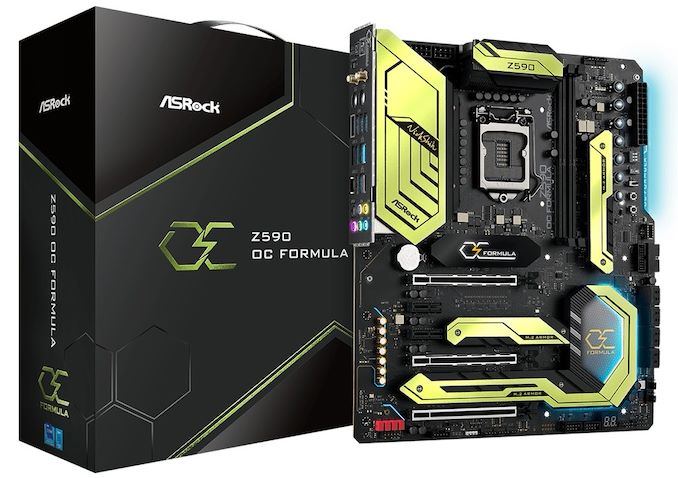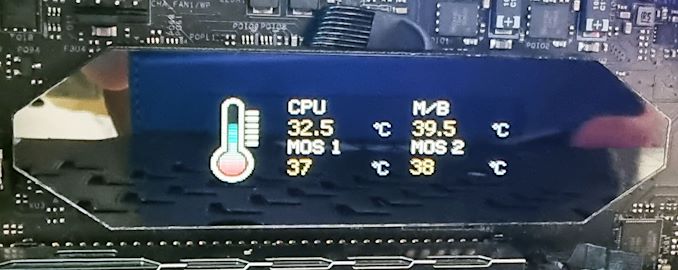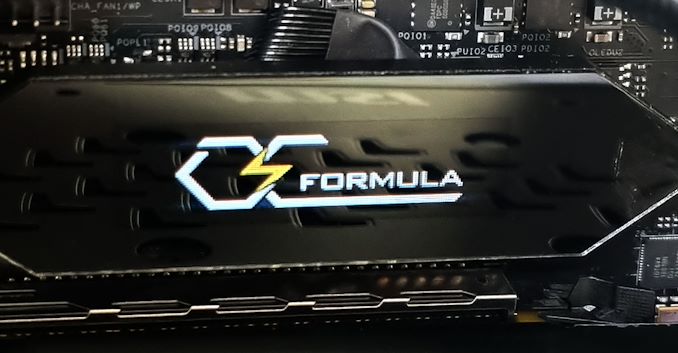The ASRock Z590 OC Formula Review: An Iconic Brand Revival
by Gavin Bonshor on September 10, 2021 9:00 AM ESTConclusion: Too Extreme for Regular Users?
The ASRock Z590 OC Formula is a solid offering. The design is aimed at extreme overclockers, with many of the board's features and design traits focused on offering the best possible performance. This includes the memory, the power delivery, the PCB design, and the firmware options. But what is built for that market has the potential to be worth it for regular users. When it comes to regular performance or pushing thermals, the ASRock Z590 OC Formula does a great job.
Other features of the Z590 OC Formula include a solid networking tripleheader that includes an Intel I225-V 2.5 GbE and Intel I219-V Gigabit controller pairing and Intel's latest AX210 Wi-fi 6E CNVi. ASRock also includes plenty of support for PCIe 4.0 devices, including two full-length slots operating at x16 and x8/x8, with one PCIe 4.0 x4 M.2 slot for the fastest available NVMe storage. Other PCIe and storage options include one full-length PCIe 3.0 x4 slot, two PCIe 2.0 x1 slots, and two PCIe 3.0 x4 M.2 slots. Interestingly, the PCIe 4.0 x4 M.2 slot is located next to the memory slots, which frees more area around the CPU socket to mount LN2 pots without any restrictions safely.
Focusing on a stock performance level in our test suite, we felt that the OC Formula was quite power-hungry in our long idle and idle power testing but remained competitive when under full-load. In our non-UEFI POST time and DPC latency, the OC Formula performed respectively. Focusing on our computation and gaming performance, the ASRock was competitive with other models on test.
Looking at 'daily' overclocking performance, we saw excellent levels of VDroop when testing each frequency from 4.7 to 5.3 GHz. We managed to hit 5.3 GHz all-core stable on this board with 1.45 V set on the CPU VCore, but this proved too much for our Corsair 360mm AIO cooler, and we did get some thermal throttling, even though only 92ºC was observed. So if thermal headroom can be made, there seems to be some room to push.
There is also an extensive overclocker's toolkit to play around with, which caters to extreme overclockers. In our power delivery thermal tests, the OC Formula performs very well against other boards - showcasing that if the power delivery itself was to be thermally limited, there's plenty of room at the inn. The active design works well combined with the 12-layer board and heatsinks here.
. The overall design implementation of the Z590 OC Formula is aesthetically pleasing. Some highlights that we want to mention include a dual BIOS switch on the rear panel is a particular highlight in terms of design implementation and a fully-function OLED display that can display live telemetry data on voltages, temperatures, and fan speed. From previous iterations of the OC Formula series, I have to say I prefer the older vibrant yellow as it pops more and looks unique. However, we can see where ASRock is coming from with the slightly acidic yellow color scheme on the Z590 version.
Final Thoughts: For Overclockers, By Nick Shih
While it's true ANY of the Z590 motherboards can be used under extreme conditions, boards such as the ASRock Z590 OC Formula are designed specifically for that purpose. When it comes to Nick Shih, not only is he a legend of the overclocking game, but he has infused his personal characteristics into the design of the OC Formula, and having spoken to him about this, he is super proud of the new OC-focused products he can bring to the market. While some vendors usually get help from an extreme overclocker to help design OC profiles, the ASRock Z590 OC Formula is personally designed by Nick Shih as lead engineer, and he hasn't just lent his name for the sake of branding.

Nick using Z590 OC Formula and Liquid Nitrogen to run the CPU at -193ºC / -314F
Wrapping up our review of the ASRock Z590 OC Formula, not only is it a formidable and premium board for extreme overclockers to attempt and hopefully break world records on, but it's also functional enough for the everyday user. As always with these sorts of boards, while ehe expensive price tag of $550 is justifiable for extreme overclockers who don't bat an eyelid in paying $1000+ for a pre binned CPU, for the regular user, there are much more cost-effective options on the market. For this money, on Z590, double the memory slots and options like Thunderbolt 4 and 10 G networking are available for the price.
That being said, it looks good, and it's a revival of a unique marque of an iconic band. While perhaps day-to-day overclocking isn't as important as it used to be, sometimes it's fun to notice the rising mist and peak over the fence to see what the overclockers are cooking (or in this case, cooling).













20 Comments
View All Comments
Kracken'm all - Friday, September 10, 2021 - link
Frankly overpriced and useless if we are being scalped hard for higher end cpu and gpu.Actually mobo manufacturers should pay us on top using their board as nvidia and amd are fucking everything up so bad but just don't give a crap but fakers for money.
prophet001 - Friday, September 10, 2021 - link
HPCs are like fishing lures... they're not made to catch fish they're made to catch fishermen.I feel embarrassed thinking about some of the stuff I bought and bought into when I was younger.
Wrs - Friday, September 10, 2021 - link
Why would you blame or take out your anger on a mobo maker for a shortage of cpus/gpus caused by a biological virus?!The mobo is a beast and seems priced at a slight *discount* to the market. Let's hope it's dependable because I don't know about that warranty... probably explains the discount.
For those that don't appreciate on-board power buttons and resets/switches and metal backplates because its all covered by a computer case, get a cheaper board, this one isn't for you. It's a niche product painfully torn between mass-market usability and catering to a small community of hardcore overclockers. Because it includes features for two mutually exclusive audiences, it's always going to be at least somewhat overpriced to either group.
The only complaint I'd have is the placement of that on-board OLED display. It's likely to be obscured by insulation or high end air cooling. Probably should get rid of it, buff up the diagnostic display to a full time monitoring display.
TheinsanegamerN - Monday, September 13, 2021 - link
"Why would you blame or take out your anger on a mobo maker for a shortage of cpus/gpus caused by a biological virus?!"Still on that theory? That's cute. There's plenty of GPUs shipping out of china, they just are not coming to us.
" It's a niche product painfully torn between mass-market usability and catering to a small community of hardcore Suckers."
FTFY. All this money and design for another 50 MHz bin over a normal $180 Z series board. The days of hardcore OCingbeing entertaining ar ebehind us when CPUs hit 95% of that performance level on their own now.
Wrs - Monday, September 13, 2021 - link
What? It's generally accepted that Covid is the primary cause of the chip shortage, but far from the only cause. Covid produced quarantines and lockdowns, messed with factory production here and there, made a lotta people scramble for electronics to work from home - there's the impact on both supply and demand. There are some compounding factors like China tariffs, an island off China running out of water (I don't say that with a straight face), car industry cutting orders before a surprise sales boom, and other details I needn't list here.Overclocking is legit, but getting more niche these days - on that you are absolutely right. The mainstream has trended toward what formerly was entry level OC - big beefy ambient coolers. I don't particularly like the inefficient Rocket Lake to start - inefficiency is what necessitates expensive boards, after all - but this article isn't about a board built for mainstream cooling, and 50 MHz is certainly not all you're expected to get over a $180 board... though perhaps it is close to all you'll get using what this site did, an ambient AIO cooler. That's just not right to cool >300w in half a square inch, nor is it any good for reducing thermal and electrical resistivity in silicon. Rocket Lake runs so hot, the minimum you'd need to see real progress is ice water. This board, with all its slow boot switches, is clearly set up for phase change or LN2, and I am not prepared to ask Anandtech to cough up that kind of expertise...
Spunjji - Monday, September 13, 2021 - link
"Frankly overpriced and useless"Yes
*everything else you wrote*
No
svan1971 - Friday, September 10, 2021 - link
AsRock before you buy check out their warranty info its a disaster.Slash3 - Friday, September 10, 2021 - link
The first board in the series was the Z77 OC Formula, not the Z87. I've still got mine running in a secondary system. :)Slash3 - Friday, September 10, 2021 - link
One other note, the testbed chart lists an 11900K with pricing of $374, which is clearly incorrect.AllMuscle1 - Friday, September 24, 2021 - link
Same here! I was about to laugh when I saw it clearly displayed in the photograph and yet, he stated Z87. The Z77 for Ivy Bridge was amazing! It's now in my daughter's system.